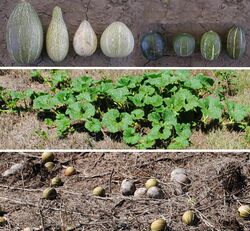Biology:Cucurbita andreana
| Cucurbita andreana | |
|---|---|

| |
| Cucurbita andreana fruits (top), plant in the middle of the season (middle) and fruits left at the end of the season (bottom). The opaque ones are fruits left on earlier seasons from a different plant on the same place. | |
| Scientific classification | |
| Kingdom: | Plantae |
| Clade: | Tracheophytes |
| Clade: | Angiosperms |
| Clade: | Eudicots |
| Clade: | Rosids |
| Order: | Cucurbitales |
| Family: | Cucurbitaceae |
| Genus: | Cucurbita |
| Species: | C. andreana
|
| Binomial name | |
| Cucurbita andreana Naudin
| |
| Synonyms[1] | |
| |
Cucurbita andreana is a plant species of the genus Cucurbita,[1][2] since 1982 in the rank of a C. maxima subspecies, C. maxima subsp. andreana, the wild relative of C. maxima subsp. maxima cultivated subspecies. It is native to Argentina and Uruguay. C. andreana fruits are smaller and not palatable, those of C. maxima (or C. maxima subsp. maxima) are bigger and palatable.[2]
The species Cucurbita maxima originated in South America from wild C. andreana over 4,000 years ago.[3] The two species hybridize quite readily but have noticeably different calcium levels.[4] C. andreana has yellow flowers and bright green striped fruit. It prefers full sun and well drained soil. Extrafloral nectaries are present in C. maxima but not necessarily in C. andreana.[5]
The species was formally described by Charles Victor Naudin in 1896, in Revue Horticole.[1]
References
- ↑ 1.0 1.1 1.2 {{citation | mode = cs1 | title = Cucurbita andreana | work = Germplasm Resources Information Network (GRIN) | url = | publisher = [[Organization:Agricultural Research ServAgricultural Research Service (ARS), United States Department of Agriculture (USDA) | access-date = September 10, 2013 }}
- ↑ 2.0 2.1 Nee, Michael (1990). "The Domestication of Cucurbita (Cucurbitaceae)". Economic Botany (New York: New York Botanical Gardens Press) 44 (3, Supplement: New Perspectives on the Origin and Evolution of New World Domesticated Plants): 56–68. doi:10.1007/BF02860475.
- ↑ Sanjur, Oris I.; Piperno, Dolores R.; Andres, Thomas C.; Wessel-Beaver, Linda (2002). "Phylogenetic Relationships among Domesticated and Wild Species of Cucurbita (Cucurbitaceae) Inferred from a Mitochondrial Gene: Implications for Crop Plant Evolution and Areas of Origin". Proceedings of the National Academy of Sciences of the United States of America (Washington, DC: National Academy of Sciences) 99 (1): 535–540. doi:10.1073/pnas.012577299. PMID 11782554. PMC 117595. Bibcode: 2002PNAS...99..535S. http://www.pnas.org/content/99/1/535.full.pdf.
- ↑ Skilnyk, Hilary R.; Lott, John N. A. (1992). "Mineral analyses of storage reserves of Cucurbita maxima and Cucurbita andreana pollen". Canadian Journal of Botany 70 (3): 491–495. doi:10.1139/b92-063.
- ↑ López-Anido, Fernando; Vesprini, José (2007). "Extrafloral Nectaries in Cucurbita maxima Sub. andreana (Naudin) Filov". Cucurbit Genetics Cooperative Report (Raleigh, NC: North Carolina State University) 30: 38–42. http://cuke.hort.ncsu.edu/cgc/cgc30/2007toc.html.
External links
Wikidata ☰ Q15533102 entry

